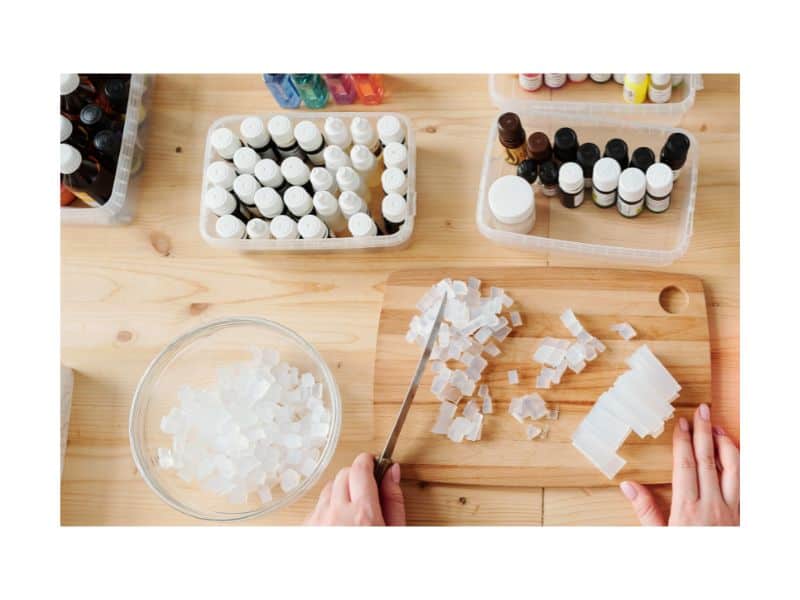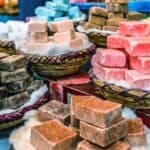Soap is a necessity in our daily lives, but not all soap bases are created equal. With so many options available in the market, it can be challenging to determine the safest melt and pour soap bases to use. We are going to discuss the criteria for a soap base to be considered safe and identify the safest soap base to use.
Castile soap base is among the safest soap bases that you can use. It is all-natural, vegan, renewable, and has a pH of 8.9 which is in the correct range for soap. However, everyone is different and some individuals may prefer a different soap based on their sensitivity level.
Another safe option for soap bases is glycerin-based soaps. Glycerin is a natural byproduct of the saponification process and it helps to retain moisture in the skin. It also acts as an emollient, making it ideal for people with dry skin. Let’s take a look at some popular soap bases.
The Safest Soap Base to Use
Criteria for Safe Soap
To determine the safest soap base, we must consider several factors, including ingredients, pH level, fragrance and color, sustainability, and certifications.
- Ingredients: The soap base should contain safe, natural ingredients that are not harmful to the skin or the environment. It should not contain any synthetic fragrances, preservatives, or artificial colors.
- pH level: The soap base should have a pH level that is close to that of the skin, which is around 8-10. A soap base with a higher or lower pH level can irritate the skin.
- Fragrance and color: The soap base should use natural, non-toxic fragrance and color additives. Synthetic fragrances and dyes can cause skin irritation and allergic reactions.
- Sustainability: The soap base should be made with sustainable and environmentally friendly ingredients. It should not contain any harmful chemicals that can pollute the environment.
Understanding The Different Types of Soap Bases
Now that we have identified the criteria for the safest soap base, let’s compare the different types of soap bases based on these criteria.
- Glycerin soap base: Glycerin soap base is made from vegetable oil and glycerin. It is transparent and moisturizing, making it suitable for sensitive skin. However, it can contain synthetic fragrances and colors, which can be harmful.
- Coconut oil soap base: Coconut oil soap base is made from coconut oil and other natural ingredients. It is gentle and moisturizing, making it ideal for dry and sensitive skin. However, it may not be sustainable as coconut oil production can have a negative impact on the environment.
- Shea butter soap base: Shea butter soap base is made from shea butter and other natural ingredients. It is moisturizing and gentle, making it ideal for sensitive skin. However, it may not be suitable for those with nut allergies.
- Olive oil soap base: Olive oil soap base is made from olive oil and other natural ingredients. It is moisturizing and gentle, making it ideal for sensitive skin. However, it can be expensive and not as readily available as other soap bases.
- Castile soap base: Castile soap base is made from olive oil and other natural ingredients. It is gentle and moisturizing, making it ideal for sensitive skin. It is also sustainable and environmentally friendly.
- Goat’s milk soap base: Goat’s milk soap base is made from goat’s milk and other natural ingredients. It is moisturizing and gentle, making it ideal for sensitive skin. However, it may not be suitable for vegans.
Identification of The Safest Soap Base
Based on the criteria we identified, the safest soap base to use is the Castile soap base. It is made from natural ingredients, has a pH level of 8.9, uses natural fragrance and color additives, and is sustainable and environmentally friendly.
Additionally, it is suitable for all skin types, including sensitive skin.
Chemical Ingredients to Avoid
It’s important to avoid certain chemicals and additives that may be harmful to your skin and overall health.
Here are some ingredients to watch out for:
- Sodium Lauryl Sulfate (SLS): This chemical is a foaming agent that can be harsh and drying to the skin, and has been linked to skin irritation and other health concerns.
- Synthetic fragrances: These are often made from a mixture of chemicals that can cause skin irritation and may be linked to hormone disruption and other health issues.
- Parabens: These preservatives are commonly used in cosmetics and personal care products, but have been linked to hormone disruption and other health concerns.
- Propylene glycol: This chemical is often used as a humectant and can help to keep skin moisturized, but may also be linked to skin irritation and other health concerns.
- Synthetic dyes: These are often added to soap to give it color, but may be made from a variety of chemicals that can be harmful to your health.
- Triclosan: This antibacterial agent is commonly used in soaps and other personal care products, but has been linked to antibiotic resistance and other health concerns.
Look for products that are free from these ingredients and instead contain natural and organic ingredients. Some options may include using soap bases that are made with ingredients like shea butter, coconut oil, and essential oils.
Natural Additives for Melt and Pour Soap
Here are some natural additives to consider for your next batch of melt and pour soap:
- Herbs and Botanicals: Dried herbs and botanicals can be added to soap for color, texture, and skin-nourishing properties. Some popular options include lavender, calendula, chamomile, and rose petals.
- Clays: Natural clays like kaolin, bentonite, and French green clay can be added to soap for their cleansing, exfoliating, and oil-absorbing properties.
- Oils and Butters: Natural oils and butters like coconut oil, shea butter, and cocoa butter can be added to melt and pour soap for added moisturizing benefits.
- Essential Oils: Essential oils can be added to soap for natural fragrance and therapeutic benefits. Some popular options include lavender, tea tree, peppermint, and eucalyptus.
- Honey: Honey can be added to melt and pour soap for its moisturizing and antibacterial properties.
Melt and Pour Soap Safety
Melt and pour soap bases are generally considered safe for use, as long as they are used according to their intended purpose and with proper precautions. These soap bases are typically made from a combination of natural and synthetic ingredients, which may vary depending on the manufacturer and product.
One of the advantages of melt and pour soap bases is that they are pre-made and do not require the use of lye, which can be a caustic and dangerous substance when not handled properly. This makes melt and pour soap bases a good option for those who want to make soap at home but do not want to work with lye.
Frequently Asked Questions
Melt and pour soap bases can be purchased and used at home to create custom soaps with various additives, colors, and scents.
Some benefits of using melt and pour soap include ease of use, versatility in creating custom soaps, and the ability to avoid working with lye.
Yes, fragrance can be added to melt and pour soap using essential oils or fragrance oils.
Yes, layered and marbled soap can be made with melt and pour soap by pouring different colors or layers into the same mold and allowing each layer to cool before adding the next.
Conclusion
In conclusion, the safest base to use is the Castile soap base, which is made from natural ingredients, and has a pH level of 8.9, and is sustainable and environmentally friendly. Additionally, it is considered suitable for all skin types, including sensitive skin. Melt-and-pour soap bases are also generally considered safe for use as long as they are used with proper precautions.
When choosing a soap base look for products that are free from harsh chemicals like SLS, parabens, propylene glycol, synthetic dyes, and triclosan and instead contain natural ingredients such as shea butter and coconut oil. With these factors in mind, you can make sure your soaps are safe to use while still being effective at cleansing






